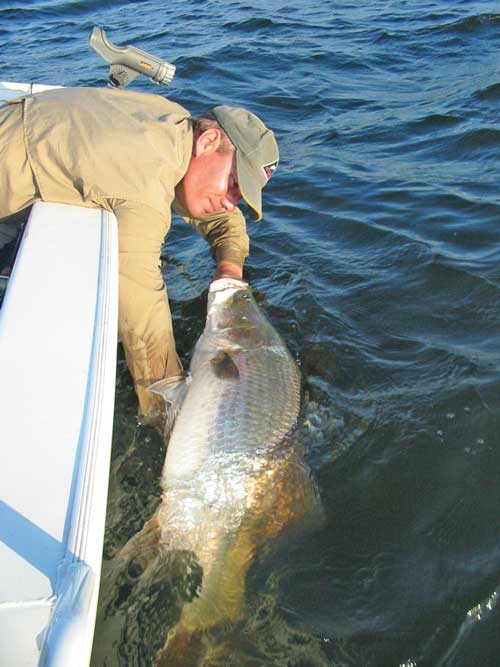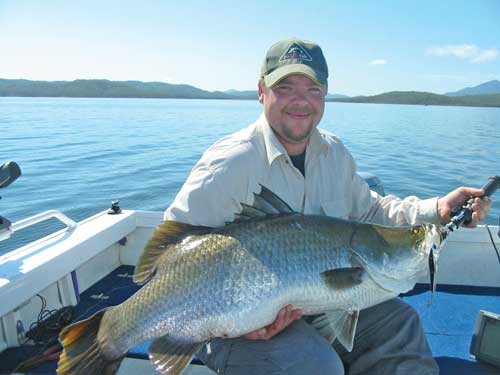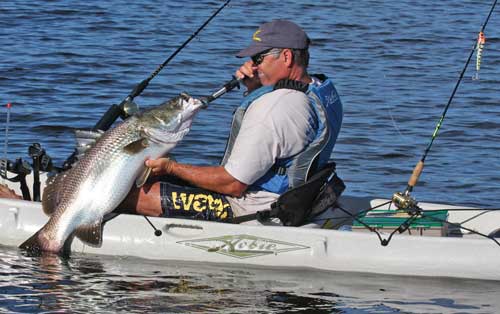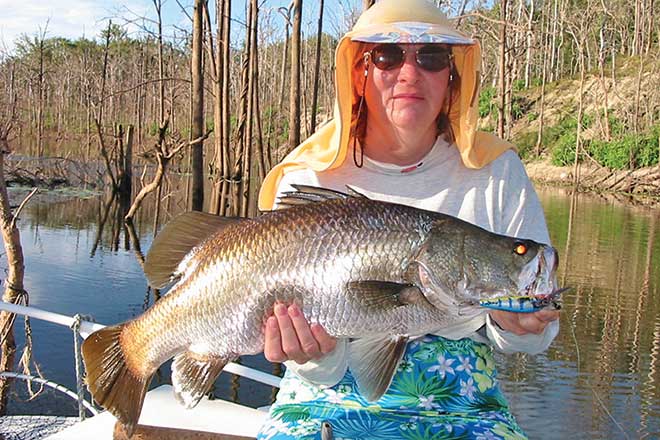Way back in 1998, I was invited by Queensland Fisheries staff from Walkamin to visit Lake Tinaroo in an attempt to achieve repeatable results on the temperamental barramundi living there.
Locals from Cairns had been struggling on the lake despite angling barramundi very successfully in saltwater environs.
Our approach was to call on our extensive experience on southern Queensland’s stocked lakes, putting temperate still-water tactics to the test in the tropics.
We were pleasantly surprised by the success of that first excursion, with fish in excess of 1m hooked during the first afternoon.
During the second afternoon, we landed three barramundi – from a petite 11kg specimen to a 1.25m leviathan.
Over the course of the following week, we achieved similar results with 1m plus barra caught every afternoon.

Trolling in the dark
Why were we achieving consistent repeatable success when locals struggled to take even a strike?
Simply put… we didn’t use barramundi techniques, using instead exactly the same methods proven successful on Murray cod in lakes close to home.
The only change we made was to use a slender barramundi-style lure instead of the chunky wide-actioned models used for cod.
During that first excursion and during the 25 years since, the standout trolling lure for impoundment barramundi has been the Predatek Viper.
Colour preferences change occasionally, however the first Redhead pattern I had so much success with during those early years still kicks goals.
Ghostrider, Tarpon and Barra Blue are common to see on the lines of successful anglers too.
The most success on that first and numerous subsequent sojourns at Tinaroo was had by trolling in 4-5m of water from sunset until about 10pm.
Yes, trolling – a tactic some seem to have an aversion to but it should not be overlooked.
Trolling allows areas to be explored quickly, which can be quite advantageous during a trip of short duration when time on the water is precious.
Lures were run around 15m behind the boat, travelling at idle while following the depth contour.
Shorelines without masses of drowned trees were chosen simply because landing a 20kg barra in thick timber in the dark was unlikely to be successful.
Slow is the catch word when it comes to trolling impoundments for barramundi.
Idle speed in my 4.2m tinnie with a well-tuned 30hp Honda is spot on.
A good electric with ample battery storage would no doubt be just as effective, possibly even better.
Our time at Tinaroo was so productive that we saw no need for further captures on that lake and headed south to fish lakes elsewhere.

Anchor and cast
Wind the clock forward a few years and Lake Awoonga near Gladstone has been stocked with barra for a couple years now, making it ripe for an exploratory visit.
As was the case with Tinaroo, Awoonga was proving a tough nut to crack, though our early forays did yield captures each visit.
Early outings there saw us sticking with our proven trolling methods from several years of regular trips to Tinaroo.
By the mid-2000s and after a drop in lake levels, it became known that anchoring and casting around the fringes of the lake was a great way to connect to a barramundi or two.
Several lure manufacturers and my wife and I hired a houseboat for a solid week of product testing on the lake’s big barra.
Casting at dusk along the shorelines of relatively shallow bays proved to be the most productive technique, with quite a few quality fish being caught and released by all team members.
Logically, in lakes with hundreds of kilometres of shoreline to fish, not all fringes will yield barramundi on any given day.
Trial and error indicated that, early and late in the season, the downwind shore will hold more feeding fish than upwind areas.
This is due to the surface water warmed by the sun being blown to the downwind side.
Being most active in warmer water, barramundi will bite best in areas with elevated temperatures – even by only a few degrees.

You can identify this without a temperature reading because the baitfish on which barra feed – namely snub-nosed garfish and bony bream – can be seen flicking on the surface.
Select a bay with plenty of baitfish activity and cruising barramundi will eventually arrive, though it can take some patience to sit in one spot casting repeatedly without a hit.
Proven from decades of fishing barramundi lakes, the most productive casting technique for us was to anchor within casting distance of the shore and blind cast.
Retrieves are what is known in some circles as ‘the barra twitch’.
The barra twitch can be challenging to learn but once mastered comes quite naturally and can be repeated for hours on end.
A short rod is best as the retrieve is made with the tip held low and flicked downwards in a short sharp snap of the wrist.
The rod tip only moves 30cm or so, just enough to have the lure dart forwards the same distance.
As the rod tip is lifted for the next twitch, slack line is retrieved and the lure pauses – this is often when the barra hits.
We have had extraordinary success ‘twitching’ with the Predatek SandViper – the shallow version of the lure used for trolling.
For a smaller lighter casting lure, the same manufacturer makes an 85mm lure called the Spoonbill, which has caught scores of impoundment barra using the same retrieve.
As long as the water temperature is right and there is plenty of baitfish activity, you can confidently sit in one spot for at least an hour casting before moving.
Once you’ve hooked a barra in any given lake, it is worth returning to that spot and putting in long sessions.
Success breeds success too, so you’ll be able to seek out similar spots in barra lakes right around the state with a good chance of duplicating those results.
Now is the right time of year to be on the lakes chasing these awesome fish, though naturally not all lakes will be firing at the same time.
Currently, Lake Monduran is the pick of the southern locations, with barra right through the size range from yearlings to monsters being caught.
All of the northern lakes will produce fish at this time of year – you simply need to be on the water investing a little time to pinpoint their current feeding locations.
Good luck.
 Bush ‘n Beach Fishing Magazine Location reports & tips for fishing, boating, camping, kayaking, 4WDing in Queensland and Northern NSW
Bush ‘n Beach Fishing Magazine Location reports & tips for fishing, boating, camping, kayaking, 4WDing in Queensland and Northern NSW









